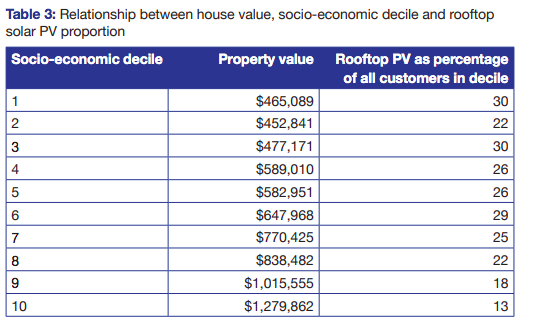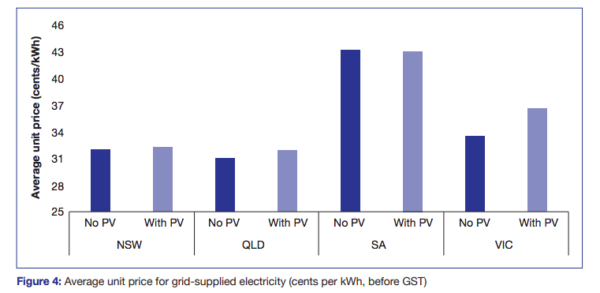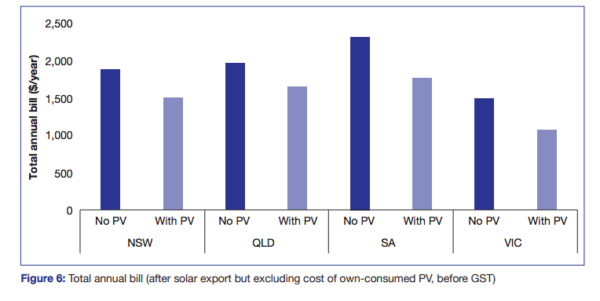While in Australia’s ongoing energy debate, owners of households with rooftop solar PV are often labelled as having a high income or being ‘wealthy retirees’, a new report has showed an inverse relationship between rooftop solar PV uptake and socio-economic rank.
Released by the Victoria Energy Policy Climate and commissioned by Solar Citizens, the report has analyzed electricity bills of 10,051 households provided by the consumer group Choice, including more than 2,000 from households with PV, in Queensland, South Australia, New South Wales and Victoria.
The findings showed that rooftop PV is helping low to middle income households get their bills back under control, while well-off households are much less interested in putting solar on their rooftops.

“There is probably a range of reasons. One is they are not sensitive to prices as much, I think secondly they might have roofs that are shaded,” said Bruce Mountain, Associate Professor at the Victoria Energy Policy Center.
Regardless of income, on average, the households with solar PV had electricity bills that were approximately 20% lower than households without PV, the Australia’s Rooftop Real Estate report finds.
The number of Australian rooftop solar PV systems passed the two million mark late last year, with an average six panels installed a minute, while both residential and commercial grew by more than 40%, reaching 1,227 MW and 351 MW respectively.
The main drivers for home owners to install PV continue to be high electricity prices and falling costs of solar accompanied by a shorter payback period.
“Energy prices are going through the roof, everyone knows that. The only sure way to bring down energy bills is by putting solar on your roof,” Solar Citizens’s national director, Joseph Scales, said.
However, the majority of Australian rooftops are still available for rooftop PV. As shown in an earlier report, commissioned by Solar Citizens and compiled by the Australian Photovoltaic Institute and the University of New South Wales, Australia’s rooftop PV potential stands at an incredible 43 GW to 61 GW — well above the approximate 8 GW that’s currently installed.
Myth busted! Opponents of renewable energy like to pigeonhole solar owners as ‘champagne sippers and the latte set’ but we’ve just proved them wrong.
Our latest report shows that solar is proportionately the most popular in low socio-economic areas and on less valuable homes. pic.twitter.com/7RREHMl9I4
— Solar Citizens (@solarcitizens) February 24, 2019
Energy retailers still making a mint
The report also found that a staggering one third of all the PV households analyzed were paid less for the electricity they fed into the grid than retailers would otherwise pay on the spot market.
“Retailers profit from this to the extent that they do not pass this on to other customers in lower prices,” the report states.
This finding directly stands at odds with the common misconception that non-solar households pay for the feed-in tariffs that solar households receive, the report states, noting that those exporting power back to the grid are actually subsidizing those without solar panels.
The report shows that households in these four states, particularly in Victoria, pay slightly higher average unit (cents per kWh) prices for their grid-supplied electricity than households without PV. “The fixed component of residential electricity bills in Australia generally, and in Victoria, in particular, is higher than in any other country we know of,” states the report.

On average, households with rooftop solar PV buy about 9% less electricity from the grid than households without PV. However, they also consume, on average, a quarter more electricity than those without PV, the report finds.
To address this, Solar Citizens has called on state and territory governments to mandate a minimum feed-in tariff to stop electricity retailers profiteering from households with solar PV.

This content is protected by copyright and may not be reused. If you want to cooperate with us and would like to reuse some of our content, please contact: editors@pv-magazine.com.








I’m not sure what myth-busting analysis was required? The CER data has always shown this to be the case… and was clearly evident during Australia’s first solar boom. Despite this data being widely available, any residential solar retailer of scale knows that both anecdotally and via their own customer postcode data exactly where their typical customers live!